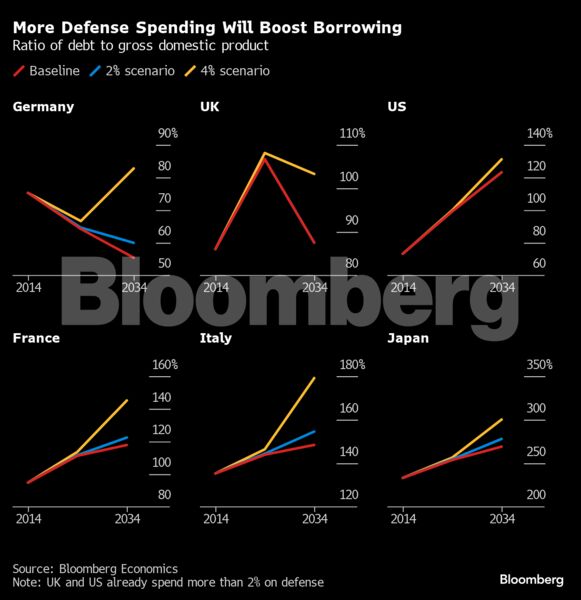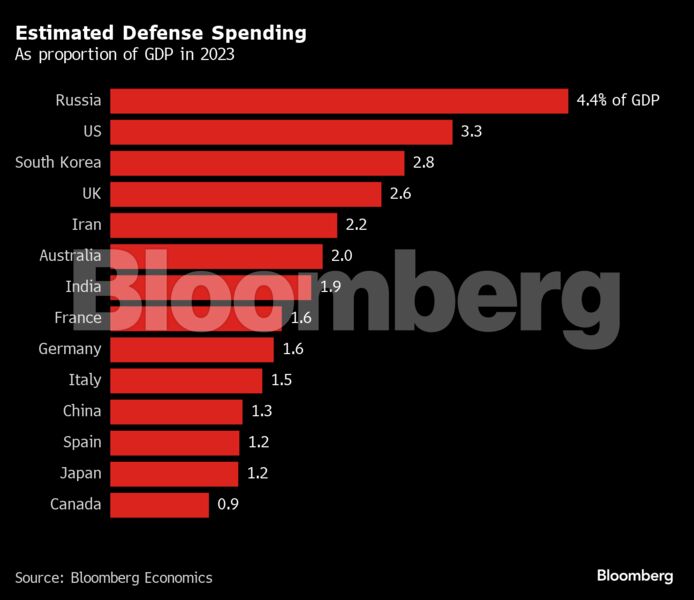UK To Remove Andrew From Role As Royal Navy Vice Admiral
LONDON, Nov 2 (Reuters) – Britain’s former prince Andrew is due to be stripped of his last remaining military position as part of King Charles’ decision to remove his brother from public...
By Enda Curran, Natalia Drozdiak and Bhargavi Sakthivel (Bloomberg) A new era of global rearmament is gathering pace, and it will mean vast costs and some tough decisions for western governments already struggling with shaky public finances.
Despite world defense spending reaching a record $2.2 trillion last year, European Union nations have only just begun to consider what 21st-century security will require with an aggressive Russia stirring on their eastern borders, a volatile Middle East, and the expansion of the Chinese military tugging Washington’s attention toward the Pacific.
Political leaders have been congratulating themselves on the progress toward NATO’s targets for members of the alliance to set aside 2% of their gross domestic product on defense. But officials focused on security say that military budgets may need to emulate Cold War spending of as high as 4% in order to deliver on the alliance’s plans.
If the US and its Group of Seven allies were to reach such levels, that would equate to more than $10 trillion of additional commitments over the next decade, according to calculations by Bloomberg Economics.
“The post-Cold War ‘peace dividend’ is coming to an end,” said Jennifer Welch, BE’s chief geoeconomics analyst. “That’s likely to have a transformative effect on defense companies, on public finances and on financial markets.”
The brutal reality for the US and its allies is that Vladimir Putin’s advances in Ukraine mean they need to dramatically ramp up their defenses in eastern Europe at the same time as they counterbalance China — just as that country increases cooperation with Moscow.

President Xi Jinping has been clear about his ambition to bring Taiwan under Beijing’s control, by force if necessary, and has increasingly asserted China’s territorial claims elsewhere in the Asia Pacific region.
Those twin threats are pushing western leaders — and their voters — to confront problems over taxes, welfare and government borrowing that have been building for years, as they come to terms with the tradeoffs that the return of great power competition will bring.
“I don’t foresee a fiscal crisis triggered by elevated defense spending,” said Simon Johnson of the Massachusetts Institute of Technology, who was previously chief economist at the International Monetary Fund. “But I do worry about a national security crisis caused by a failure to defend your country.”
Analysis from Bloomberg Economics shows how the increasing burden of preparing for war will create a new fiscal paradigm for most NATO members.
Even just meeting the alliance’s 2% of annual GDP minimum for military outlays would stall much of the EU’s post-pandemic debt consolidation. Getting to 4% would push the bloc’s weaker sovereigns to make painful choices between even deeper levels of borrowing, significant cuts in other parts of the budget, or else tax increases.
France, Italy and Spain would be particularly exposed if the extra spending is funded through bond markets, with Rome’s public debt jumping to 179% of output by 2034 from 144% this year.
Even the US, which is already allocating 3.3% of its annual GDP on defense, would see borrowings increase to 131% from 99% over the next decade if it pushed its military budget to 4%.
The implications may feature when the IMF releases updated debt forecasts next week at its spring meetings. Its officials have already told countries to gradually start rebuilding fiscal buffers amid growth that is likely to be weaker in the next half decade than before the Covid-19 pandemic.

While the wars in Ukraine and Gaza have focused attention on Europe and the Middle East, the surge in military budgets is a global phenomenon.
China’s defense spending will grow by 7.2% in 2024 — the most in five years. Malaysia tops year-on-year growth projections for 22 Asia-Pacific nations with a 10.2% increase and total outlays of $4.2 billion this year, according to analysis by defense intelligence firm Janes. That’s followed by 8.5% growth for the Philippines with $6.6 billion.
In the US, President Joe Biden’s administration will request a 1% increase for a military budget that already dwarfs that of any other nation and Matthew Kroenig of the Atlantic Council says it may need to double as a percentage of GDP. “The US is nowhere near where it needs to be,” he said.
How a remilitarized world can reconcile such commitments with finite tax revenues and ever-greater welfare and health needs is set to become a searing political question in the years ahead.
It’s with that in mind, and the prospect of a second term for NATO-skeptical Donald Trump, that the EU’s 27 leaders in late March kicked off difficult discussions over how to finance a major overhaul of their defense sector while also maintaining aid to Kyiv. Trump’s February comments in March sowing doubt over US aid for Europe in the event of war brought added urgency to those talks.
Despite such worries, NATO members are unlikely to agree to a firm commitment to spend as much as 4% of GDP on defense any time soon. They agreed last year to sharpen their pledge to spend at least 2%, but even that drew intense debate.
For investors, the most appealing option would be to expand the issuance of jointly-backed euro bonds that funded the EU post-pandemic recovery plan. Such a structure would take advantage of the clamor for more AAA-rated European securities and cushion individual countries from the increasing burden.
All the same, a prolonged era of higher interest rates that now looks likely could yet stoke debt servicing charges and narrow public finance options, especially if it’s coupled with significantly higher defense spending.
And if governments duck politically hard decisions, that might only ensure borrowing costs remain high, according to Christopher Smart, a former senior economic policy official at the US Department of the Treasury and the White House.
“We live in a world of politicians who prefer guns and butter,” said Smart, who is now managing partner of the Arbroath Group. “So I don’t know that it is going to force a whole lot of difficult choices, it will just lead to more debt, which will itself drive up rates.”
Those concerns are also behind the opposition to joint bond issuance from fiscal hawks in wealthier nations like Germany. Chancellor Olaf Scholz, speaking last month, didn’t rule out the issuance of joint bonds categorically but didn’t show much enthusiasm either. “We are not such big fans of such ideas,” he told reporters.
The backdrop to such discussions is NATO’s plan to deliver one of the biggest overhauls of its defenses since the end of the Cold War.
The alliance is aiming to put around 300,000 troops at higher readiness, with members able to scale up eight multinational battle groups on its eastern flank, each of currently around 1,000 troops, to reach brigade size of as many as 5,500.
“More is urgently needed,” said Oana Lungescu, an analyst at the London-based thinktank RUSI and a former NATO spokesperson.
The alliance needs to fill long-standing gaps such as air defense, to replenish weapons and ammunitions stocks, and to keep investing in new technologies to maintain its advantage over Russia, she said. Ukraine will also need ongoing support as it endures a third year of war with Russia.
While all that may incur costs that political leaders have barely begun to calculate, it’s probably still better than the alternative, according to Johnson of MIT.
“You have to weigh that against what happens if you don’t spend the money,” he said. “What does that mean for your country, your economy and for investors?”
By Enda Curran, Natalia Drozdiak and Bhargavi Sakthivel © 2024 Bloomberg L.P.

Sign up for gCaptain’s newsletter and never miss an update

Subscribe to gCaptain Daily and stay informed with the latest global maritime and offshore news
Essential news coupled with the finest maritime content sourced from across the globe.
Sign Up